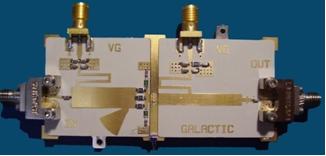MMIC
MMIC and HMIC DESIGN
The research activity devoted to HMIC and MMIC design has also dealt with the development of suitable design methodologies. In particular, "direct" design procedures were developed which enable an optimal choice of the design parameters to be determined. The main goal is to obtain a suitable, sufficiently accurate design which can be used as a good starting point for circuit optimisation. These methodologies provide the designer with a clear, immediate view of the compromise between different circuit requirements as a function of the main design parameters. This enables a sufficiently accurate initial design to be obtained in a very short time.
|
Recently, a new approach to electron device characterisation oriented to power amplifier design has been developed. In particular, a two-source low-frequency load-pull setup is used to characterise the device "resistive core" (i.e., the part of the intrinsic device subject to the most important dispersive, thermal and non-linear effects and responsible for output power delivery) which in conjunction with a look-up table description of the device capacitances can be successfully adopted for power amplifier design. |
 |
Different HMIC and MMIC circuits were designed in cooperation with several industrial, research and academic partners: X-band MMIC Doppler sensor, highly-linear cold-FET mixers, 20 GHz GaAs HFET and 35 GHz GaAs PHEMT power amplifiers, X-band HBT and PHEMT power amplifiers, L- and X-band GaN high-power amplifiers, wideband PHEMT LNAs, DROs and push-push VCOs, etc..
The research in this field led to the foundation of the academic spin-off MEC srl in 2004.


